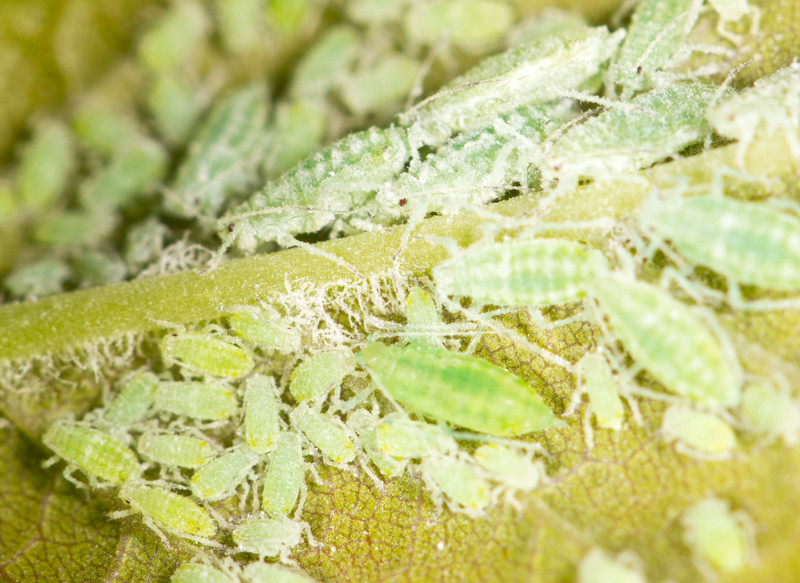Aphids are small, pear-shaped, soft-bodied insects. There are many species of aphids ranging in color from green to pink to black to dusty gray or white with a fluffy coating. Aphids are 1/32 to 1/8 inch in length. Nymphs are similar to adults.
Aphids live in colonies. They are slow-moving and usually are found in clusters. They are usually wingless, but when colonies become crowded winged adults leave to form new colonies.
Good Products for Pest and Disease Control at Amazon:
- Garden Safe Snail and Slug Bait
- Bonide Sulfur Fungicide
- Monterey BT Caterpillar Killer
- Neem Bliss 100-% Cold Pressed Neem Oil
- Safer Brand Insect Killing Soap
- PyGanic Botanical Insecticide
Aphid eggs overwinter on woody stems; they hatch in spring. Females give birth to live nymphs without mating. Nymphs mature in one to two weeks. In the fall, males and females are born, then mate and produce overwintering eggs.

Feeding aphids can transmit diseases such as mosaic virus.
A large aphid outbreak may be a symptom of excessive nitrogen fertilizer application (resulting in tender plant growth) and the excessive use of pesticides that kill beneficial aphid predator insects.
Scientific name: Aphis fabae (bean aphid), Myzus persicae (spinach aphid), Acyrthosiphon pisum (pea aphid), Eriosoma lanigerum (woolly aphid).
Target plants
Aphids attack the soft tissue of vegetables, fruits, and ornamental plants including new growth of woody plants.
Feeding habits and damage
Aphids suck the juices from tender vegetables, fruits, and ornamental plants. Their feeding causes leaf, bud, and flower distortion. Aphids secrete sticky honeydew that supports the growth of sooty mold on leaves and fruit. Aphids can spread viral diseases.
Organic controls
A strong blast of water will dislodge aphids. Bacillus thuringiensis (BT) spray, insecticidal soap, and seaweed spray applied to the whole garden; insecticidal soap on undersides of new growth, make 2 to 3 applications every 2 weeks when pests are seen; horticultural oil spray for fruit trees; diatomaceous earth dusting of the plant; aluminum foil mulch will repel aphids; yellow sticky traps. Pyrethrum and rotenone sprays can be applied to serious infestations.
Organic control calendar
Here is what you can do seasonally to control aphids:
- Before planting: Plant cover crops such as rye, vetch, and clover which are havens for aphid predators. Nasturtiums are a trap crop. Plan crop rotation so that the same kind of crop does not grow in the same place 2 years in a row; this will prevent aphid larvae from finding the host plant a second year.
- At planting time: Plant resistant varieties—varieties resistant to aphids and the diseases they carry. Interplant crops with chives, garlic, mints, onions, and petunias which repel aphids. Fleece floating row covers to exclude pests from seedlings and transplants.
- While crops develop: For light infestations spray smaller plants frequently with a strong stream of water to knock aphids off—at least every other day until the colony is gone. Use insecticidal soap every 2 to 3 days for large infestations; use homemade garlic sprays (mix chopped garlic with water) or hot pepper sprays—these sprays must hit the aphids to kill them; as a last resort, spray with neem or pyrethrin.
- After harvest: Plant cover crops such as rye, vetch, and clover which are havens for aphid predators.
Natural predators
Lacewing, ladybug, braconid and chalcid wasps, assassin bugs, big-eyed bus, damselflies, ground beetles, hoverflies, minute pirate bugs, predatory thrips, soldier beetles, and spiders. Animal predators include chickadees, nuthatches, purple finches, warblers, chipping sparrows, and toads.
Related articles:
Vegetable Garden Diseases Problem Solver
Vegetable Garden Organic Weed Control
Vegetable Garden Organic Pest Control
Garden Planning Books at Amazon:
- Vegetable Garden Grower’s Guide
- Tomato Grower’s Answer Book
- Vegetable Garden Almanac & Planner
- Kitchen Garden Grower’s Guide Vegetable Encyclopedia



